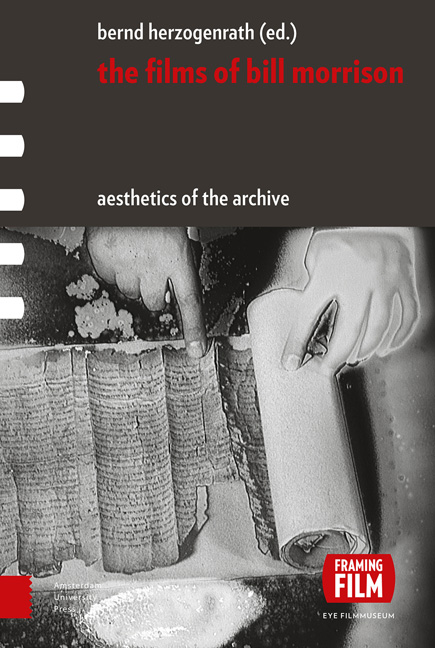Book contents
- Frontmatter
- Contents
- Acknowledgments
- Aesthetics of the Archive: An Introduction
- Chapter 1 Drafts and Fragments: Reflections around Bill Morrison and the Paper Print Collection
- Chapter 2 The Film of Her: The Cine-Poet Laureate of Orphan Films
- Chapter 3 Ghost Trip: Searching for Potential Myths
- Chapter 4 Decasia: The Matter | Image: Film is also a Thing
- Chapter 5 The Mesmerist: Illustrating the Return of the Repressed
- Chapter 6 Light is Calling: Celluloid Dreams
- Chapter 7 Gotham: Zoetrope: Block by Block
- Chapter 8 Outerborough: Early Cinema Revisited
- Chapter 9 The Highwater Trilogy: Thinking the Liquid – On the Ethics of Water and the Material Ecologies of Disaster and Ruination
- Chapter 10 Porch: Archives, Collective Memory, and the Poetics of Home Movies
- Chapter 11 The Future Lasts Long: The Romanov Lost Family Archives
- Chapter 12 Who by Water: Variations on Matter, Figures, Memory, and Mythology
- Chapter 13 Every Stop on the F-Train: Beyond and within the Restless Netherworld of (Manhattan’s) Mind
- Chapter 14 Spark of Being: Bachelor Machine
- Chapter 15 The Miners’ Hymns: Acts of Resurrection
- Chapter 16 Tributes – Pulse: A Requiem for the 20th Century: Death | Drive | Image
- Chapter 17 Just Ancient Loops: The Loops of Life in Intonation
- Chapter 18 The Great Flood: Water is Transparence Derived from the Presence of Everything
- Chapter 19 Re-Awakenings: Bill Morrison in Conversation
- Index of Film Titles
- Index of Names
- Index of Subjects
- Already Published
Chapter 19 - Re-Awakenings: Bill Morrison in Conversation
Published online by Cambridge University Press: 12 December 2020
- Frontmatter
- Contents
- Acknowledgments
- Aesthetics of the Archive: An Introduction
- Chapter 1 Drafts and Fragments: Reflections around Bill Morrison and the Paper Print Collection
- Chapter 2 The Film of Her: The Cine-Poet Laureate of Orphan Films
- Chapter 3 Ghost Trip: Searching for Potential Myths
- Chapter 4 Decasia: The Matter | Image: Film is also a Thing
- Chapter 5 The Mesmerist: Illustrating the Return of the Repressed
- Chapter 6 Light is Calling: Celluloid Dreams
- Chapter 7 Gotham: Zoetrope: Block by Block
- Chapter 8 Outerborough: Early Cinema Revisited
- Chapter 9 The Highwater Trilogy: Thinking the Liquid – On the Ethics of Water and the Material Ecologies of Disaster and Ruination
- Chapter 10 Porch: Archives, Collective Memory, and the Poetics of Home Movies
- Chapter 11 The Future Lasts Long: The Romanov Lost Family Archives
- Chapter 12 Who by Water: Variations on Matter, Figures, Memory, and Mythology
- Chapter 13 Every Stop on the F-Train: Beyond and within the Restless Netherworld of (Manhattan’s) Mind
- Chapter 14 Spark of Being: Bachelor Machine
- Chapter 15 The Miners’ Hymns: Acts of Resurrection
- Chapter 16 Tributes – Pulse: A Requiem for the 20th Century: Death | Drive | Image
- Chapter 17 Just Ancient Loops: The Loops of Life in Intonation
- Chapter 18 The Great Flood: Water is Transparence Derived from the Presence of Everything
- Chapter 19 Re-Awakenings: Bill Morrison in Conversation
- Index of Film Titles
- Index of Names
- Index of Subjects
- Already Published
Summary
ABSTRACT
An interview between Lawrence Weschler, who commissioned Re:Awakenings (2013), with Bill Morrison.
KEYWORDS
Re:Awakenings, Oliver Sacks, Philip Glass.
Lawrence Weschler: In considering the genesis of Reawakenings, the documentary we did with Oliver Sack's material, maybe I should start. As you know, I had known Oliver Sacks at that point, in 2013, for something like 35 years and indeed, at one point, in the early 1980s, had been getting set to do a biography of him. In the event, we had agreed, he and I, that I wouldn't do that (he had issues around his sexuality, which, at the time, he did not feel comfortable having talked about, though, just recently, that has changed and he is talking about them in his own newly released autobiography), but we stayed friends. And, in 2013, I was working with the eminent dancer Bill T. Jones, who wanted to start a humanities festival in his NY Live Arts dance space and have me curate it, an annual festival to be themed around body issues widely understood (mind-body, body-soul, body-politic, and the like); and we agreed that a great way to start would be to devote the entire five-day 20-event festival to the work and worlds of Oliver Sacks. (The next year we did the work and worlds of James Baldwin and the year after that, Laurie Anderson.) But, in any case, the first one was to be Oliver Sacks.
And I knew, knowing Oliver, that he had a box somewhere in a closet in his Greenwich Village apartment, containing something like fifteen reels of super-8 footage that he himself had taken at the time of the great awakening of his patients, those remarkable months back in 1969, just before and just after, when he’d brought a group of deeply frozen patients rearing back to life. These were patients who had been entirely entranced, as if living statues, for at that point coming on for 20 or 30 years. And suddenly, because of the administration of the so-called wonder-drug L-Dopa, he was able to bring them back to vivid life, though they then encountered all sorts of complex tribulations.
- Type
- Chapter
- Information
- The Films of Bill MorrisonAesthetics of the Archive, pp. 277 - 288Publisher: Amsterdam University PressPrint publication year: 2017



